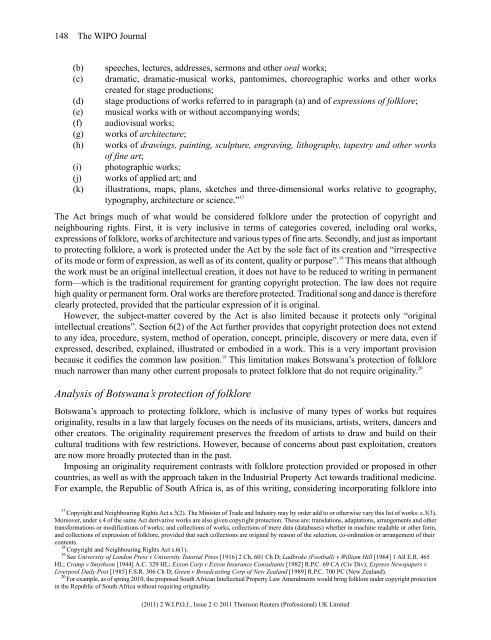WIPO Journal - World Intellectual Property Organization
WIPO Journal - World Intellectual Property Organization
WIPO Journal - World Intellectual Property Organization
Create successful ePaper yourself
Turn your PDF publications into a flip-book with our unique Google optimized e-Paper software.
148 The <strong>WIPO</strong> <strong>Journal</strong><br />
(b) speeches, lectures, addresses, sermons and other oral works;<br />
(c) dramatic, dramatic-musical works, pantomimes, choreographic works and other works<br />
created for stage productions;<br />
(d) stage productions of works referred to in paragraph (a) and of expressions of folklore;<br />
(e) musical works with or without accompanying words;<br />
(f) audiovisual works;<br />
(g) works of architecture;<br />
(h) works of drawings, painting, sculpture, engraving, lithography, tapestry and other works<br />
of fine art;<br />
(i) photographic works;<br />
(j) works of applied art; and<br />
(k) illustrations, maps, plans, sketches and three-dimensional works relative to geography,<br />
typography, architecture or science.” 17<br />
The Act brings much of what would be considered folklore under the protection of copyright and<br />
neighbouring rights. First, it is very inclusive in terms of categories covered, including oral works,<br />
expressions of folklore, works of architecture and various types of fine arts. Secondly, and just as important<br />
to protecting folklore, a work is protected under the Act by the sole fact of its creation and “irrespective<br />
of its mode or form of expression, as well as of its content, quality or purpose”. 18 This means that although<br />
the work must be an original intellectual creation, it does not have to be reduced to writing in permanent<br />
form—which is the traditional requirement for granting copyright protection. The law does not require<br />
high quality or permanent form. Oral works are therefore protected. Traditional song and dance is therefore<br />
clearly protected, provided that the particular expression of it is original.<br />
However, the subject-matter covered by the Act is also limited because it protects only “original<br />
intellectual creations”. Section 6(2) of the Act further provides that copyright protection does not extend<br />
to any idea, procedure, system, method of operation, concept, principle, discovery or mere data, even if<br />
expressed, described, explained, illustrated or embodied in a work. This is a very important provision<br />
because it codifies the common law position. 19 This limitation makes Botswana’s protection of folklore<br />
much narrower than many other current proposals to protect folklore that do not require originality. 20<br />
Analysis of Botswana’s protection of folklore<br />
Botswana’s approach to protecting folklore, which is inclusive of many types of works but requires<br />
originality, results in a law that largely focuses on the needs of its musicians, artists, writers, dancers and<br />
other creators. The originality requirement preserves the freedom of artists to draw and build on their<br />
cultural traditions with few restrictions. However, because of concerns about past exploitation, creators<br />
are now more broadly protected than in the past.<br />
Imposing an originality requirement contrasts with folklore protection provided or proposed in other<br />
countries, as well as with the approach taken in the Industrial <strong>Property</strong> Act towards traditional medicine.<br />
For example, the Republic of South Africa is, as of this writing, considering incorporating folklore into<br />
17 Copyright and Neighbouring Rights Act s.3(2). The Minister of Trade and Industry may by order add to or otherwise vary this list of works: s.3(3).<br />
Moreover, under s.4 of the same Act derivative works are also given copyright protection. These are: translations, adaptations, arrangements and other<br />
transformations or modifications of works; and collections of works, collections of mere data (databases) whether in machine readable or other form,<br />
and collections of expression of folklore, provided that such collections are original by reason of the selection, co-ordination or arrangement of their<br />
contents.<br />
18 Copyright and Neighbouring Rights Act s.6(1).<br />
19 See University of London Press v University Tutorial Press [1916] 2 Ch. 601 Ch D; Ladbroke (Football) v William Hill [1964] 1 All E.R. 465<br />
HL; Cramp v Smythson [1944] A.C. 329 HL; Exxon Corp v Exxon Insurance Consultants [1982] R.P.C. 69 CA (Civ Div); Express Newspapers v<br />
Liverpool Daily Post [1985] F.S.R. 306 Ch D; Green v Broadcasting Corp of New Zealand [1989] R.P.C. 700 PC (New Zealand).<br />
20 For example, as of spring 2010, the proposed South African <strong>Intellectual</strong> <strong>Property</strong> Law Amendments would bring folklore under copyright protection<br />
in the Republic of South Africa without requiring originality.<br />
(2011) 2 W.I.P.O.J., Issue 2 © 2011 Thomson Reuters (Professional) UK Limited

















